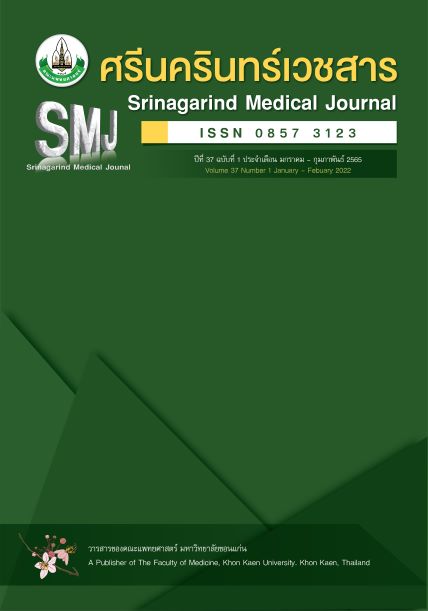การอักเสบติดเชื้อในช่องเยื่อหุ้มคอชั้นลึกของผู้ป่วยที่เขารับการรักษาในโรงพยาบาลร้อยเอ็ด
Abstract
Deep Neck Infections of In-patients at Roi Et Hospital
บทคัดย่อ
วัตถุประสงค์: เพื่อศึกษาลักษณะทั่วไปของผู้ป่วย ตำแหน่งการติดเชื้อ เชื้อแบคทีเรียที่เป็นสาเหตุ และผลการรักษาการอักเสบติดเชื้อในช่องคอชั้นลึก (Deep neck infection) ของผู้ป่วยที่นอนโรงพยาบาลร้อยเอ็ด
วิธีการศึกษา: รูปแบบการวิจัยเป็นการศึกษาเชิงพรรณนาแบบย้อนหลัง โดยเก็บรวบรวมข้อมูลจากเวชระเบียนผู้ป่วยในที่เข้ารับการรักษาที่หอผู้ป่วย โรงพยาบาลร้อยเอ็ด ในระหว่างวันที่ 1 มกราคม 2558 ถึง 31 ตุลาคม 2563 จำนวน 137 ราย โดยข้อมูลที่ศึกษาได้แก่ ข้อมูลพื้นฐานทั่วไปของผู้ป่วย ภาวะแทรกซ้อน ตำแหน่งการติดเชื้อ เชื้อแบคทีเรียที่เป็นสาเหตุ วิธีการรักษา การวิเคราะห์ข้อมูลใช้สถิติเชิงพรรณนา
ผลการศึกษา: พบว่าผู้ป่วยส่วนมากเป็นเพศชายร้อยละ 59.85 อายุเฉลี่ย 47.12 ปี (SD=22.01) ส่วนมากมีโรคประจำตัวเป็นเบาหวานร้อยละ 22.63 อาการแสดงส่วนมากมีไข้ร้อยละ 97.81 ปวดบวมบริเวณลำคอหรือใบหน้าร้อยละ 91.97 เจ็บคอร้อยละ 80.29 กลืนลำบากร้อยละ 75.18 กลืนเจ็บร้อยละ 75.91 อ้าปากได้น้อย/ขากรรไกรแข็งร้อยละ 57.66 ตำแหน่งการติดเชื้อส่วนมากบริเวณ Submandibular space ร้อยละ 36.50 Buccal space ร้อยละ 15.33 และ Parotid space ร้อยละ 10.95 ผลการเพาะเชื้อพบว่าส่วนมากเป็นเชื้อ Klebsiella pneumoniae ร้อยละ 11.68 Staphylococcus aureus ร้อยละ 5.11 Beta hemolytic streptococcus ร้อยละ 2.92 Alpha hemolytic streptococcus ร้อยละ 2.92 Enterococcus faecalis ร้อยละ 2.19 Proteus mirabilis ร้อยละ 1.46 ผู้ป่วยส่วนมากได้รับการรักษาด้วยยาปฏิชีวนะร่วมกับผ่าตัดระบายหนองร้อยละ 64.96 รักษาด้วยยาปฏิชีวนะอย่างเดียวร้อยละ 30.66 รักษาด้วยยาปฏิชีวนะร่วมกับผ่าตัดระบายหนองและเจาะคอร้อยละ 4.38 ผลการรักษาหาย/ดีขึ้นร้อยละ 99.27
สรุป: ผู้ป่วยติดเชื้ออักเสบติดเชื้อในช่องคอชั้นลึกที่เข้ารับการรักษาในโรงพยาบาลร้อยเอ็ดส่วนมากติดเชื้อบริเวณ Submandibular space โดยเชื้อที่เป็นสาเหตุส่วนมากเป็นเชื้อ Klebsiella pneumoniae ส่วนมากได้รับการรักษาด้วยยาปฏิชีวนะร่วมกับผ่าตัดระบายหนองและรักษาหายเกือบทุกราย
คำสำคัญ: ติดเชื้ออักเสบติดเชื้อในช่องคอชั้นลึก, ตำแหน่งการติดเชื้อ, เชื้อแบคทีเรียก่อโรค
Objective: To study the general characteristics of patients, sites of infection, bacteria that cause of infection, and outcome of Deep-Neck Infection treatment of patients at Roi Et Hospital.
Methods: This study was a retrospective descriptive study. All data were collected from medical records of patients at Roi Et Hospital from January 1, 2015, to October 31, 2020. The total number of study subjects were 137 cases. The variables of interest include general characteristics of patients, site of infection, bacterial cause of infection, and methods of treatment. The statistical analyzed were used descriptive statistics.
Results: The study subjects most of them were male 59.58%, mean age 47.12 years (SD=22.01), underlying diseases with diabetes mellitus 22.63%, the most presenting symptoms were fever 97.81%, pain and swelling around the neck or face 91.97%, sore throat 80.29%, dysphagia 75.18, odynophagia 75.91%, and trismus 57.66%. The sites of infection were submandibular space 36.50%, buccal space 15.33%, and parotid space 10.95%. The bacterial cultures found were Klebsiella pneumoniae 11.68%, Staphylococcus aureus 5.11%, Beta hemolytic streptococcus 2.92%, Alpha hemolytic streptococcus 2.92%, Enterococcus faecalis 2.19%, and Proteus mirabilis 1.46%. Most of the patients were treated by antibiotics along with pus drainage surgery 64.96%, treat with antibiotics only 30.66%, and antibiotic treatment with pus drainage surgery and tracheostomy 4.38%, and the treatment result was improved 99.27%
Conclusion: Patients with Deep-neck infections who have been admitted at Roi Et Hospital most of them were infected at submandibular space, Klebsiella pneumoniae was the most of infection. Most of them used antibiotics for treatment with pus collection drainage, and most of the patients were cured.
Keywords: Deep-neck infections; site of infection; pathogens


